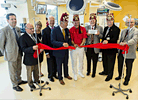Education & Training
Shriners Hospital opens leading-edge simulation centre
September 21, 2016

MONTREAL – The Shriners Hospital for Children – Canada has opened a Pediatric Simulation Centre that includes a host of patient simulation tools. The Centre delivers high-fidelity, realistic simulations for surgical, medical, nursing, respiratory therapy and allied health practitioners.
It offers a safe, realistic environment, allowing health professionals and students to increase their knowledge, hone their skills, and practice teamwork in the context of realistic patient scenarios. The Pediatric Simulation Centre at Shriners Hospitals for Children – Canada is the only such centre in the Shriners’ network of 22 hospitals.
“Modern medical education requires novel teaching modalities. Medical simulation has become an integral part of any modern healthcare curriculum,” says Dr. Reggie Hamdy, chief of staff, Shriners Hospital for Children – Canada.
“Our goal is to promote excellence in pediatric healthcare in a family-centered environment by using medical simulation to improve the knowledge, skills, and behaviour of health professionals and establish a culture of continuous professional development. Our intent is to become no less than a nationally and internationally recognized centre of excellence in pediatric medical simulation.”
In addition to José, a simulator that represents a six-year-old boy, the state-of-the-art centre comprises several dedicated rooms for simulation-based education and training.
It includes a multipurpose surgical skills lab, with six surgical stations with retractable booms with suction, and hospital-grade air with six radiolucent adjustable beds.
Traditionally, surgical skills have been acquired in the operating room (OR). The complexity of surgical procedures and the premium placed on surgical time have increased. So, rather than taking up precious OR time with teaching, surgical residents can now acquire and perfect their skills in the surgical skills lab.
“The surgical skills laboratory is revolutionizing surgical training,” says Jean A. Ouellet, M.D., medical director of the Pediatric Simulation Centre. “Using computer simulators and virtual reality technology, as well as specially designed procedure models, surgical residents learn a wide array of surgical skills.
At the instructor’s station, high-fidelity cameras film, record, and transmit the teacher’s directives to the other five surgical stations where students replicate the teacher’s moves. Surgeries can also be broadcast live from the OR and transmitted via secure server to the surgical skills lab and/or the two designated conference rooms.
“The educational activities we are hosting and developing are based on the educational needs of our health professionals,” says Dr. Ouellet. “We will ensure that we have faculty trained in medical simulation from all disciplines and specialties; including pediatric orthopaedics, pediatric surgery, anesthesia, nursing, and respiratory therapy.”
Inter-professional training sessions are being held in the Pediatric Simulation Centre and in clinical settings such as the operating room, patient rooms or even the hospital cafeteria.
Training sessions may involve José or actors who participate in scenarios that help health professionals learn how to deal with various situations, such as how to calm an anxious parent, how to talk and interact with children of different ages or how to ensure a patient education session is effective. Over the next few months, as the Centre ramps up, simulations will increase progressively.
There is a growing demand for simulation-based activities to be integrated into the curriculum for residency training, maintenance of skills for current practitioners, nursing training and training in the use of new devices and surgical techniques.
Many of the medical specialties have integrated simulation into their curriculum to teach residents. Schools of nursing have developed simulation education modules to teach their students and for professional development for those already in practice. This work will be encouraged through partnerships with McGill University and the Montreal Children’s Hospital of the McGill University Health Centre.
“Simulation plays an essential role on campus in McGill’s new undergraduate medical curriculum, as well as in its other professional health programs,” says Dr. Sam Benaroya, associate vice-principal and vice-dean (Health Affairs), McGill University.
“In an increasingly complex environment that is continually being enhanced by new knowledge pedagogy and technologies, simulation ensures students learn to deliver the highest quality, safest care in a setting that presents zero risk to the patient. Bringing simulation into the clinical setting represents a major step, and we look forward to working with Shriners Hospitals for Children – Canada and the Pediatric Simulation Centre to build on the educational opportunities it offers.”
About Shriners Hospitals for Children – Canada
Established in Montreal in 1925, Shriners Hospitals for Children – Canada is the only Canadian establishment within the network of 22 Shriners Hospitals. The others are located in the U.S. and Mexico. The bilingual, short-term, acute care hospital provides ultra-specialized orthopaedic care to children from coast to coast in Canada, the U.S. and around the world.
